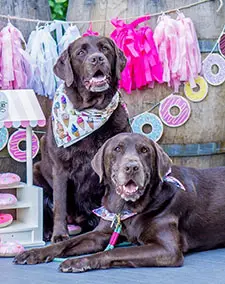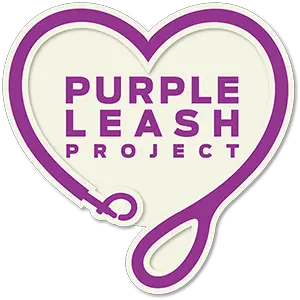The number one cause of choking incidents for dogs is rawhide chews. Second place goes to tennis balls. But there are many other hazards that might surprise you – food packaging, chew toys, sticks, and dog-safe food like carrots.
So that none of us have to experience this nightmare, I’m sharing information about preventing dog choking incidents. This post is inspired by two women in the pet industry who I’ve had on my podcast who have partnered to mark National Pet Choking Prevention Day on June 22nd.
Dr. Judy Morgan is a renowned veterinarian who has spent 36 years as a practicing veterinarian, with 10 of those years in the ER. Partnering with Dr. Judy on this initiative is Johnna Devereaux of Bow Wow Labs. Together their mission is to help get pet choking incidents down from 200,000 per year to ZERO.

Dog Choking Prevention Starts With You
Choking happens more often than we think. These are often accidents that could have been prevented with a few safety measures around the house and closer supervision of your dog when they are chewing or playing.
Dr. Judy Morgan points out that, “if your dog can find something to choke on, they will. For example, children’s toys and cat toys are too small for a dog. Other culprits include playing with the wrong size balls, strings, cords from blinds, etc.”
“Pretty much, look at everything in your house and decide, is that something that could get stuck in my pet’s throat or wrapped around my pet’s neck?”
Avoiding a choking incident starts with prevention. Here are a few things that you can do around your home to keep your pet safe from this risk:
- Chew toys and treats: These can pose a choking risk if they’re the wrong size. Make sure that your dog is playing with the appropriate-sized toy that cannot get lodged in their throat. Bigger is better!
- Cut up the foods you give them: Even dog-safe food like apples or carrots can be dangerous if you give your dog too big of a piece. You can cut these fresh fruits and veggies up into bite-sized pieces to be safer.
- Household hazards: Beware of window blind cords. These are a well-publicized risk for children and they can be just as dangerous for our pets.
- Trash: 90% of pet owners don’t realize that plastic food bags pose a big choking and suffocation risk to their dogs. Always dispose of your trash in a secure place that your dog can’t access.
- Other items: Look out for anything small and chewable like kids’ toys, hair accessories, socks, etc. If our pets find them, they might end up in their mouth.
When I got certified Pet First Aid + CPR, the instructor recommended cutting the ends off of food bags before throwing them away. Basically turning it into a sleeve instead of a bag. This not only helps your pets, but it also helps wildlife that can choke or suffocate on food bags they find in the trash.

Top Choking Hazards for Dogs
The number one cause of choking for dogs is rawhide. There are a lot of reasons why I avoid rawhide for my dogs. It’s so dangerous because it can soften up as your dog chews on it, then get stuck in their throat. If they happen to swallow it, the rawhide can cause digestive blockages because it’s not digestible. Do not give your dog rawhides!
The second biggest hazard for dogs to choke on is a ball. Dr. Judy shares why size matters in this case, “The ball should not be able to fit completely in your dog’s mouth, it needs to be bigger than what they can totally get in there.”
If your dog absolutely must play fetch with a ball, here’s the safest way to do so according to Dr. Judy, “Don’t throw balls at your dog’s face for them to catch. When they do that, that’s when they’re grabbing and gulping. It’s better to throw the ball and have your dog go after the ball to retrieve it.”
More common choking hazards listed on the National Pet Choking Prevent Day website include sticks, chew toys, bully sticks, long term chews, and food packaging as well as common household items like food, window blind cords, plastic snack bags, and baby toys.
Bully sticks are much safer than rawhides, but the trouble with these chews is that they can get very small and create a choking hazard as your dog chews it into smaller pieces. To make bully stick time safer, check out the Bow Wow Buddy. This is a durable, veterinarian-backed, and dog approved safety device that secures bully sticks. This helps prevent dogs from choking on the tail-end of a bully stick and other long-term chews.

Signs that Your Dog Is Choking
How do you know if your dog is choking? It can happen in an instant if something they are chewing on gets stuck in their throat. Always supervise your pet with chews and chew toys so that you can look out for these signs.
Symptoms to look for if your dog is choking:
- Paw at their face
- Gasping or gulping for air
- Frothing at the mouth
- Wheezing in a high-pitched tone
- Showing signs of agitation and anxiety
If you notice any of these symptoms, it’s important to act quickly. Fast action could save your dog’s life!
What to Do If Your Dog Is Choking
If your pup is choking, every second counts. Knowing what to do in these situations will help you feel calm and prepared if you ever need to jump into action.
Based on my pet first aid training, you first want to identify if your pet can cough or gag. If they can do that, there’s a better chance that they’ll be able to dislodge the object themselves.
If they don’t dislodge the item themselves quickly and you’re seeing any of the symptoms mentioned above, it’s time to jump in and help them. Your dog depends on you to be their first responder.
Here’s how you can help your dog if they are choking:
1. Check their mouth: According to Animal Emergency Center Membphis, “begin by checking inside of your dog’s mouth to see if any food or foreign objects are lodged in your dog’s mouth or throat. If you can see something, try to swipe it away with your finger to help your dog breathe again.”
You might also want to keep a hemostat or long needlenose pliers in your pet first aid kit for these situations.
2. If that doesn’t work, perform the Heimlich maneuver: You may need to perform chest compressions. To do this, place your hands on either side of your pet’s rib cage and thrust inwards and upwards. Imagine a fireplace bellows, this thrusting motion should force air up through the throat to push the object out
3. Contact your dog’s veterinarian: Even if you get the object out, it’s important to contact your vet. Choking can cause damage to your dog’s mouth or throat. If your dog went without oxygen for any amount of time, they might need to be hospitalized.
If you go to the vet, save the item that your dog was choking in a plastic bag and take it with you to show them.
If your attempts to remove the object your dog is choking on do not work, go to an emergency vet immediately!
If you live in the Pittsburgh area, I have a list of all the emergency and 24-hour vets in our region. I recommend that you check that out now and save their numbers in your phone so you don’t need to Google anything in the middle of a crisis.

Learn What to Do in an Emergency with Your Pet
I signed up for a Pet First Aid and CPR certification workshop so I could learn more helpful pet health tips to share here on my blog.
The course was so full of information that I wish every pet parent could attend a similar class. Even after 20 years of raising dogs, I learned new, important, life-saving information.
If you’re interested in getting more information about how to help your pet in case of an emergency like how to perform Heimlich maneuver, I highly recommend looking for a pet first aid class. They are often offered through your local animal shelter. I did my course at Animal Friends in Pittsburgh, PA and it was taught by a PetTech certified expert with decades of experience in animal rescue and emergency care.
Inspect Your Home for Pet Choking Hazards
The most important info that I hope you take away from this post is that you can prevent most pet choking incidents. Follow the recommendations from Dr. Judy Morgan and Johnna Devereaux and be sure to check out the website for National Pet Choking Prevention Day.
The golden rule of choking prevention is understanding your pet and keeping an eye on them. These are the two most important things to keep in mind:
- Size matters: Toys, treats, and chews should be the right size for your pet.
- Always supervise chewing: Even small toys left by human babies or toddlers can be dangerous.
In the wise words of my friend Johnna Devereaux from Bow Wow Labs, “Knowledge about common, overlooked objects is key to preventing choking.”
Now you should be able to prevent choking hazards, recognize the signs of a choking dog and help your pet in an emergency. Let’s spread awareness about pet choking prevention and ensure our beloved pets lead long, happy and healthy lives!
Learn more pet health and wellness tips in these posts:
The Best Dog Enrichment Toy According to a Pet Nutritionist
Dr. Judy Morgan’s Food Therapy for Dogs with Cancer
What to Put in your Dog First Aid Kit
The Best Enzymatic Dental Gel for Dogs






0 Comments